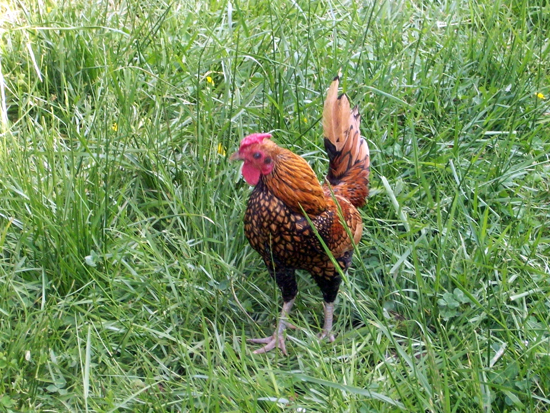National Symbols: National Bird
Rooster (common name)
Gallus gallus (scientific name)
Designation
Official
Classification
- Kingdom: Animalia
- Phylum: Chordata
- Class: Aves
- Order: Galliformes
- Family: Phasianidae
- Genus: Gallus
- Species: G. gallus
The Bird
The French national bird is the male chicken, otherwise known as a rooster. Typically found on farms, this medium-sized bird stands at about 60 centimeters (2 ft) and weighs approximately 2 kilograms (4.5 lb). The rooster’s collage-colored and often vibrant plumage can include red, orange, yellow, black, white, and brown feathers, depending on the breed. Its long tail feathers can flare into a fan-shape when the bird becomes aggressive. Roosters eat many types of foods, from insects and worms to vegetables and grain.
The polygamous rooster guards the general area where its hens are nesting and helps them find food. The rooster is known for its loud, early-morning crow, which can also be a warning cry when predators are near. Roosters are quite territorial and will normally attack other roosters that approach their territory. The bird is also known as Gallic rooster, cock, and chanticleer.
The Significance
Known as “le coq Gaulois” (the French cock) or “chanteclairs” (chanticleers) in French, the rooster’s association with France began with the simple play on words in Latin between Gallus, meaning an inhabitant of Gaul (the name of the Roman territory that is now France), and gallus, meaning rooster. The bird's use in France as a sign of royalty dates back to the Middle Ages when it was considered a symbol of bravery and vigilance. At that time the rooster was often depicted on church bells and watchtowers, which were the advanced warning systems of their day. In the medieval tales of Reynard the Fox, the chanticleer is an intelligent yet proud rooster who is tricked by the fox but eventually escapes.
During the French Revolution, the rooster’s symbolism changed, and it came to represent hope and faith, perhaps due to its wake-up call (called the “cocorico” in French), which symbolized a new dawn. The image of the Gallic rooster was included in the French flag during the revolution, and in 1848, the bird's image was officially added to the seal of the republic. In 20th-century French war-recruitment posters, the rooster was shown scratching the eyes of the Prussian eagle. In modern popular culture the rooster is considered a sign of both vanity and virility, and it appears on French stamps, currency, and as the emblem of the French national team in international sporting events (most notably for the extremely popular French national soccer and rugby teams). The rooster is also the national bird of Portugal.
Article written for World Trade Press by WTP Staff.
Copyright © 1993—2024 World Trade Press. All rights reserved.

 France
France 